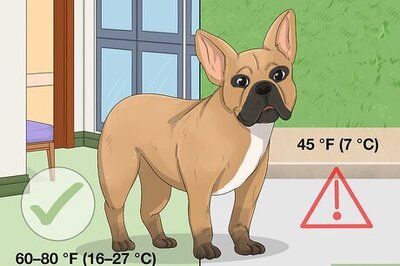
views
Why is my door not latching when I close it?
A door that won’t latch usually signals hinge or alignment issues. There are a few different problems that can cause your door not to latch, and they’re usually related to your door not sitting correctly in the frame. The most common causes for a door not latching and ways to determine the issue are: Dirty latch bolt: If the latch or strike plate hole on your door frame looks dirty or if your door handle doesn’t spring back into position, then debris may be caught in the mechanism. Loose hinges: Open your door and check the hinges to see if they feel loose or move around easily. Alternatively, close the door and check if it rubs against the door frame on the side opposite of the hinges. Raised or sunken hinges: If the hinges are sunken, then the door will rub or stop moving on the hinge side. If the hinges are raised, then the far edge of the door will rub or bump against the frame. Sagging door: Check the gaps between the door and the frame on all sides. If the gap size is different on each side or if a gap is missing, then the door is sagging in the frame. Misaligned strike plate: Place a piece of masking tape over the strike plate and cover the latch with lipstick. Close the door and reopen it to see where the lipstick marked the tape. If the marks are above or below the strike plate’s hole, then the plate or the latch are misaligned.
Fixes for a Door That Won’t Latch
Clean and lubricate the latch. If the latch is sticking or if the strike plate hole has debris in it, cleaning it out may be enough for your door to close and latch properly. Spray compressed air into the latch and strike plate hole. Also spray the keyhole if there’s a lock on the door. Apply WD-40 to the latch and turn the handle to spread the lubricant. Try closing your door and testing if the latch moves properly.
Tighten loose door hinges. When your door starts to sag or rub against the frame, loose screws on the hinges are usually the main culprit. Luckily, they’re also the easiest to fix. Open your door to expose the screws on your hinges. Use a screwdriver to tighten all of the hinge screws until they’re hand-tight. If the screw hole is stripped and the screws don’t tighten, fill the hole with wooden dowels, golf tees, or toothpicks. After that, screw the hinge back in for a secure hold.
Add longer wood screws to the hinges. Using longer screws in door hinges holds them tighter to the door jamb so they don’t sag or rub against the frame. Where you place the screw just depends on the latch’s position. If the latch is below the strike plate hole, then use a longer screw on the top hinge. For a latch that’s above the strike plate hole, place the long screw on the bottom hinge. According to home improvement specialist Ryaan Tuttle, start by taking the screws out from the hinge that’s on the door frame. Leave the other hinge attached to the door. Drive a 3 in (7.6 cm) wood screw through one of the holes in the hinge and secure it to the frame. Reattach the rest of the screws to the hinge and close the door to check that it latches.
Raise sunken hinges with shims. Wooden shims help make the hinges flush with the frame so your door doesn’t rub or get stuck. Close the door and tap out the hinge pins with a hammer and screwdriver. Remove the door from the frame. Unscrew the sunken hinges from the frame to remove them. Place a thin wooden shim in the mortise behind the hinge. Place the hinge on top to check that it’s flush with the door frame. Screw the hinge back in place. Reattach the door and hinge pins to test if it latches.
Sand the mortises if the hinges are raised. Hinges butting out from the frame can cause your door to stop and not close properly, so sanding the area behind the hinges can alleviate the issue. Close the door and remove the hinge pins with a screwdriver and hammer. Unscrew the raised hinges from the door frame. Use sandpaper to smooth out bumps and raised areas from the mortise behind the hinge. Occasionally place the hinge back in the mortise to check if it’s flush. Screw the hinge back into the frame and reattach the door.
Bend the hinges to stop the door from rubbing. According to Tuttle, when your door sags or rubs against the frame near the bottom, repositioning the door with shims and bending the hinges into place can be a simple way to make it latch again. To start, Tuttle says, “Take the bottom hinge pin out of the door and put a small shim under the knob side [of the door] to make the gap even.” He continues, “Take the hinges with a wrench and bend them a little bit [so they line up with the door] and put the hinge pin back in.” Remove the shims and the door will hang in the correct position so you’re able to close it.
File a larger hole on the strike plate. If the door latch is only off the strike plate hole by ⁄8 inch (0.32 cm), then filing the hole is the best fix. Place a rounded file at the top of the strike plate hole if the latch is too high or at the bottom if the latch is too low. Alternatively, use a rotary tool with a rounded filing bit to work faster. Apply firm pressure and push the file into the strike plate hole to shave away some of the metal. Keep filing the strike plate and testing the latch location until your door closes and latches securely.
Move the strike plate to the latch’s height. If repairs don’t work for realigning your door, then repositioning the strike plate ensures the latch lines up properly. Unscrew the strike plate from the door frame. Position the plate on the frame so it aligns with the latch and mark the location. Cut a new mortise with a chisel. Fill the original screw holes with wood dowels, toothpicks, or matchsticks. Screw the strike plate back into its new position. Fill in gaps around the strike plate with wood filler, wait for it to dry, and then paint it to match the rest of the frame.
Smooth out warps and bulges in the door or frame. If you’ve adjusted your hinges and the door still rubs against the frame, then use sandpaper or an electric sander to remove the extra material. If the frame looks warped, then sand any raised spots on the frame. If the frame is square but the door is uneven or too large, sand the door edge that’s rubbing against the frame. Only sand for a few seconds at a time before testing the door again so you don’t accidentally remove too much material. If there’s too much to sand from the door, then remove it from the frame and trim the excess material off. Just be careful not to remove so much that there are large gaps between the frame and door.
How do you fix a door that won’t lock?
Try the same fixes if your door lock is misaligned or not working. When a door won’t lock, it’s also usually an issue with the door’s latch and how it aligns with the strike plate. Start by inspecting the hinges and adjusting them before trying the other fixes. If you need to remove the knob and lock, locksmith Ray Lawrence says there are, “two screws on the edge of the door that correspond to the latch and there'd be two screws on the inside of the door that hold the mechanism together. By removing the two screws on the inside, then the lock will come apart. You can then remove the two screws on the edge of the door and remove the latch [for] a complete disassembly.”
When to Hire a Pro
Reach out to a contractor if there are larger structural issues. If none of the fixes worked on your door or if you notice your door jamb is extremely warped or sagging, you may need professional help. They will be able to run a more thorough inspection and find the root of your problem. If you’re in a rush or worried about your security, then call a pro right away to repair your door to ensure the job gets done properly.
















Comments
0 comment